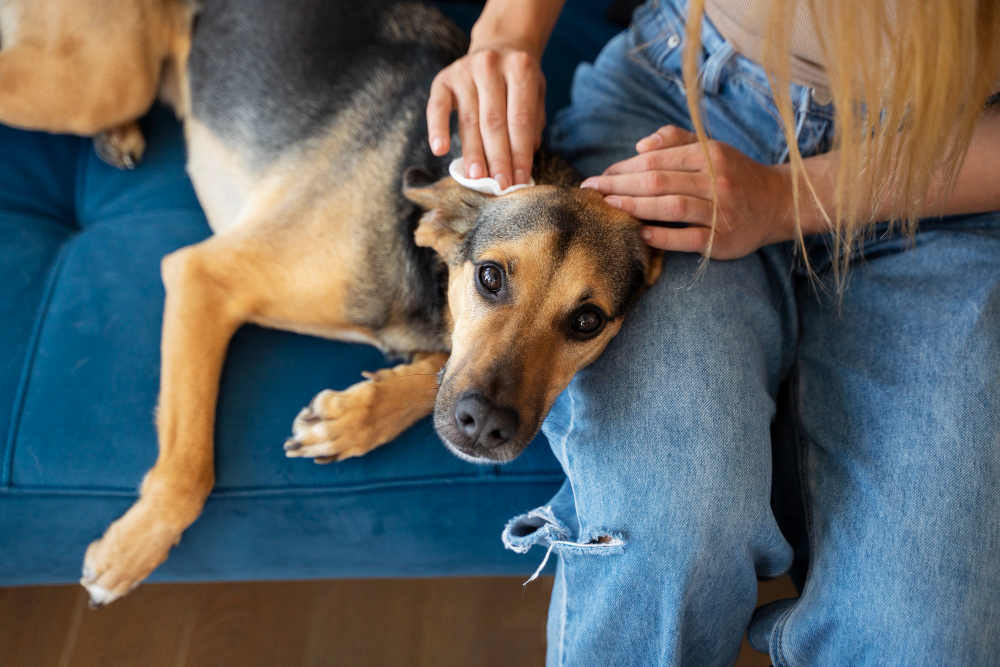

Fleas are the ultimate nuisance for dogs and their humans. These tiny, blood-sucking parasites can wreak havoc on your furry friend's comfort and health. But as common as fleas are, many pet owners remain unsure about the best ways to prevent and eliminate them. Understanding the flea life cycle and how to interrupt it can make a world of difference in your pet's well-being.
In this comprehensive guide, we'll explore the signs that your dog may have a flea problem, the risks associated with fleas, and most importantly, how you can effectively control and prevent these pesky pests.
Detecting a flea infestation early is critical for efficiently controlling them. But how can you tell if tiny fleas are causing big problems for your dog? Look out for these signs:
Visible Fleas: Check your dog's coat for small, fast-moving insects. Fleas are often found around the ears, the base of the tail, and the belly.
Excessive Scratching: If your dog is constantly scratching, biting, or licking, fleas are a likely culprit.
Hair Loss: Severe flea infestations can lead to hair loss and inflamed skin, a condition known as flea allergy dermatitis.
Flea Dirt: This is the excrement of fleas and looks like black pepper on your dog's skin or in their bed.
Restlessness: Dogs infested with fleas may be more restless due to the discomfort caused by the parasites.
Fleas are more than just an annoyance; they pose serious risks to your dog's health. The most common issues associated with fleas include:
Flea Allergy Dermatitis (FAD): FAD is a severe allergic reaction to flea bites that causes intense itching and discomfort.
Anemia: In severe infestations, fleas can cause anemia, a condition characterized by a low red blood cell count. This is especially dangerous for puppies and senior dogs.
Tapeworms: Fleas can carry tapeworm larvae, and when dogs ingest fleas during grooming, they may also ingest tapeworms.
Infectious Diseases: In some cases, fleas can transmit diseases such as bartonellosis (or cat-scratch fever), which can affect both cats and dogs.
Understanding the risks underscores the importance of vigilant flea control.
To treat fleas on your dog, it's crucial to use safe and effective products. There are several options, each with its own set of pros and cons:
Topical Treatments: These are applied directly to your dog's skin, usually on the back of the neck. They are effective for about a month.
Oral Medications: Chewable tablets are a popular choice because they treat fleas quickly and don't wash off. Some also prevent heartworms and other parasites.
Flea Collars: Collars release chemicals that kill fleas. They're long-lasting and can be a more affordable option.
Shampoos and Sprays: These provide immediate relief but do not offer long-term protection.
Always consult with your veterinarian before using any flea control products, especially if your dog has any health conditions or takes other medications.
Preventing fleas from infesting your dog in the first place is ideal. Here are some strategies for keeping fleas at bay:
Regular Grooming: Regular baths with a flea-preventing shampoo and brushing are vital for preventing fleas.
House Cleaning: Vacuum your home frequently, including your dog's bedding and any areas where they spend a lot of time. Washing your dog's bedding in hot water can also help eliminate fleas.
Environmental Treatments: Use flea control products in your home, like sprays and foggers. This is especially important if you've had a flea problem in the past.
Yard Maintenance: Keep your yard tidy by mowing the lawn and removing any brush or debris. Consider treating your yard for fleas, particularly in areas where your dog plays.
Regular Check-ups: Regular visits to the veterinarian can help you stay on top of your dog's flea control regimen and address any issues promptly.
Preventing fleas is a multifaceted approach that requires treatment of both your dog and its environment.
If you find fleas on your dog, it's important to act quickly and decisively. Here's a step-by-step plan:
1. Treat Your Dog: Use a recommended flea treatment as soon as possible. Be sure to follow the instructions carefully and continue treatment for the recommended duration.
2. Clean Your Home: Vacuum all carpets, mop all hard floors, and wash all bedding, including your dog's, in hot water.
3. Treat Your Yard: If your dog spends time outside, it's likely that fleas are in your yard. Use flea control products to treat the outdoor areas.
4. Prevent Re-infestation: Be diligent with flea preventatives to avoid another infestation. Consult your vet about the best long-term prevention options for your dog.
Remember, fleas multiply rapidly, so it's crucial to treat the problem comprehensively.
Fleas are a common problem for dogs, but they can be managed with attention and the right approach. Regular grooming, cleanliness in the home, and effective flea prevention products will help keep your dog flea-free and happy. If you're struggling with a flea infestation, don't hesitate to seek the help of a professional pet grooming service or your veterinarian. With the right strategy, you and your furry friend will be able to enjoy a pest-free life.
For residents in Columbus, OH, finding a trusted grooming salon can make all the difference. So, if you're looking for professional mobile dog grooming Columbus, OH, contact Emi Pet today to set up an appointment for your dog's grooming needs, including flea treatments and advice on ongoing prevention.